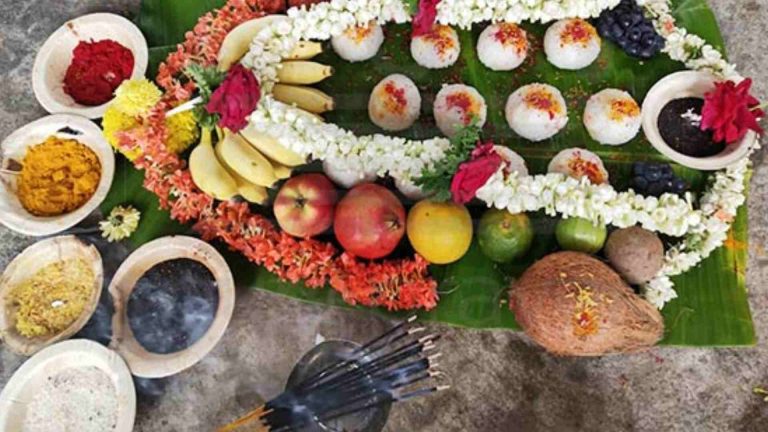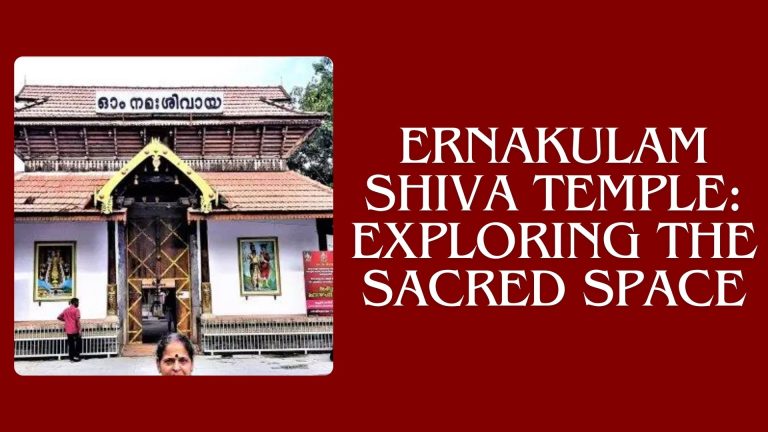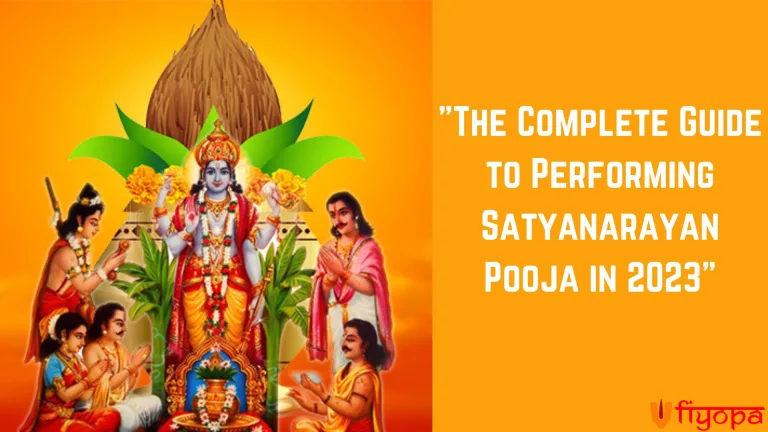The Sudarshana Homam is a sacred Vedic ritual that invokes the blessings of Lord Sudarshana, the discus of Lord Vishnu. This guide explores the benefits, step-by-step procedure for performing it at home, and the associated costs. Learn about the spiritual growth, obstacle removal, prosperity, health, and well-being that can result from this ancient practice.
TABLE OF CONTENTS
What is Maha Sudarshana Homam?
The Maha Sudarshana Homam is a Hindu ritual dedicated to Lord Sudarshana, an incarnation of Lord Vishnu. Sudarshana is seen as the divine weapon of Vishnu, symbolizing protection and the defeat of evil forces.
The homam ritual involves chanting mantras and offering materials into a sacred fire to seek protection, prosperity, and liberation from negative influences and obstacles. The Sudarshana Chakra is invoked during the homam, and the vibrations created by the mantras are believed to cleanse the environment and bestow blessings upon participants.
This homam is performed by devotees for various purposes such as overcoming enemies, warding off negativity, and seeking peace, harmony, and success in life.
Who Should Perform Maha Sudarshana Homam?
Maha Sudarshana Homam is a ritual that offers protection, prosperity, and the removal of obstacles. Individuals perform this homam for various reasons or situations:

- Protection from Negative Forces: People facing obstacles, enemies, or negative influences in their lives may perform Maha Sudarshana Homam to seek protection and overcome these challenges.
- Health Issues: Those experiencing health problems or illnesses may perform this homam to seek healing and well-being.
- Financial Problems: Individuals facing financial difficulties or seeking financial stability may perform Maha Sudarshana Homam to attract prosperity and abundance.
- Spiritual Growth: Some people perform this homam as part of their spiritual practice to deepen their connection with the divine and to progress on their spiritual path.
- Removal of Doshas: In Vedic astrology, certain planetary combinations or doshas (afflictions) may cause obstacles or challenges in one’s life. Maha Sudarshana Homam is believed to mitigate the negative effects of such doshas.
- Special Occasions: It is also common to perform this homam on special occasions such as birthdays, anniversaries, or during auspicious times according to the Hindu calendar.
Those seeking the blessings of Lord Sudarshana for protection, prosperity, and well-being can perform Maha Sudarshana Homam. Consulting with a knowledgeable priest or spiritual guide before conducting any homam is recommended to understand its significance and ensure it is done correctly.
When To Perform Maha Sudarshana Homam?
Maha Sudarshana Homam is performed on auspicious days and during specific planetary alignments by Hindu astrology. Here are some recommended times to perform Maha Sudarshana Homam:
- Specific Days:
- Ekadashi: The eleventh day of both waxing and waning moon phases (Krishna Paksha and Shukla Paksha) is considered especially auspicious for this homam.
- Dwadashi: The twelfth day of both waxing and waning moon phases is another favorable time.
- Poornima (Full Moon): The full moon day signifies completeness and is believed to enhance the potency of the homam.
- Days of the Week:
- Wednesday: Associated with Lord Vishnu’s energy, Wednesdays are generally considered ideal for rituals seeking his blessings.
- Saturday: Saturdays are another preferred day, seen as auspicious for appeasement and removing obstacles.
- Individual Needs:
- Janma Nakshatra: For a more personalized approach, some believe performing the homam on one’s birth star (Janma Nakshatra) can be particularly beneficial.
- Priest Consultation: Consulting a knowledgeable purohit (priest) is highly recommended. They can guide you based on your circumstances, astrological placements, and desired outcomes to determine the most auspicious time for the homam.
Consulting with a panditji or astrologer is recommended to determine the most auspicious time for performing Sudarshana Homam based on individual circumstances and astrological considerations. It is advised to conduct the homam with sincerity, devotion, and proper rituals.
Puja Materials Used For Maha Sudarshana Homam
| Item | Description |
|---|---|
| Basic Puja (Puja) Items | |
| Murti or Yantra | An idol or symbolic representation (Yantra) of Lord Vishnu and/or the Sudarshana Chakra. |
| Kalash | A pot made of brass or copper, filled with sacred water (sacred rivers like Ganga or Yamuna are preferred if possible), and adorned with mango leaves. |
| Panchagavya | A mixture of five sacred products from the cow – cow dung, cow urine, milk, curd, and ghee (clarified butter). |
| Betel Leaves and Nuts | Offered as a symbolic gesture. |
| Fruits and Flowers | Auspicious seasonal fruits and flowers are chosen, often including lotus flowers for Lord Vishnu. |
| Diya (Lamp) | An oil lamp with ghee or vegetable oil for lighting. |
| Incense Sticks and Agarbatti | To create a fragrant atmosphere. |
| Camphor | Used for offering aarti (light) to the deities. |
| Rice Grains (Akshata) | Uncooked rice grains are often used for offerings and as a base for the murti or yantra. |
| Coconut | A whole coconut or a broken coconut depending on the specific rituals. |
| Holy Thread (Mauli) | A sacred thread made from cotton, used for tying around the puja materials and murti/yantra. |
| Homa (Havan) Items | |
| Samidha (Firewood) | Dry sticks of specific sacred woods like sandalwood or mango wood are preferred. |
| Ghee (Clarified Butter) | Used as the primary fuel for the homa fire. |
| Homa Kund | The designated fire pit where the homa offerings are made. |
| Homa Spoon (Sruvaha) | A ladle is used for pouring ghee and other offerings into the fire. |
| Havan Samagri | A specific puja kit containing various herbs, seeds, and other sacred materials is offered into the homa fire during mantras. |
| Additional Materials (Depending on the Complexity) | |
| Abhisheka Materials | If an abhishekam (holy bath) is planned for the murti or yantra, milk, curd, honey, panchamrita (a mixture of five nectars), and various sacred powders might be used. |
| Decorations | Mango leaves, banana leaves, and colorful cloths might be used to create a mandap (sacred enclosure) or decorate the puja space. |
| Vedic Texts | The priest might use specific Vedic texts containing mantras for the homa ceremony. |
What is the Procedure For Maha Sudarshana Homam?
The Maha Sudarshana Homam is a ceremonial ritual that is typically carried out by trained priests. Here is a basic overview of the procedure to provide a general understanding:
Preparation:
- Shanti Muhurta: Consulting a Panditji(purohit) is vital. They will determine the most auspicious date and time (Shanti Muhurta) for the homam based on astrological calculations and your intentions.
- Puja Materials: The priest will acquire or recommend the puja materials (listed previously) required for the Homam.
- Mandala Setup: A sacred space (mandala) will be prepared for the homa using materials like rice grains, mango leaves, and vermillion powder.
Opening Rites:
- Sankalpa: The devotee expresses their intent and invokes the blessings of Lord Ganesha for a smooth ceremony.
- Pranayama and Shuddhi: The priest might guide participants through breathing exercises (pranayama) and purification rituals (shuddhi) to create a focused and sattvic environment.
- Abhishekham (Optional): In some ceremonies, an abhishekham (holy bath) with sacred liquids might be performed on the murti or yantra of Lord Vishnu and the Sudarshana Chakra.
Homa (Havan) Ceremony:
- Agnihotra: The sacred fire is ignited using specific mantras and procedures.
- Mantra Chanting: The priest chants powerful mantras dedicated to Lord Vishnu and the Sudarshana Chakra, invoking their divine protection and blessings.
- Havan Offerings: Throughout the chanting, various puja materials like ghee, samidha (firewood), and havan samagri (sacred offerings) are poured into the fire using the homa spoon (sruvaha).
- Ahuti: Each offering is accompanied by specific mantras (ahuti) seeking specific benefits or protections.
Concluding Rites:
- Poorna Ahuti: A final, larger offering is made to signify the completion of the homa.
- Aarti: Aarti (offering of light) is performed with lamps or camphor to the deities.
- Prasad Distribution: Blessed food (prasad) is offered to the participants as a form of divine grace.
- Shanti Mantras: Concluding mantras are chanted to invoke peace and well-being.
Important Note:
This overview provides a basic understanding. The ceremony may vary in steps and details depending on the priest’s tradition and the complexity of the homam.
Maha Sudarshana Homam Puja Mantra
“Om Namo Bhagavate Maha Sudarshana Deepthre,
Sudarshana Homam Puja Mantra
Jwala Pareethaya Sarva Digshobhanakaraya Brahmane Para Jyothishya,
Hum Phat Swaha”
Conclusion:
The Maha Sudarshana Homam is a Vedic ritual dedicated to Lord Sudarshana that provides spiritual growth, protection, prosperity, and well-being. By following the procedures and seeking guidance from knowledgeable priests, devotees can seek the blessings of Lord Vishnu’s discus to overcome obstacles, remove negativity, and achieve peace and success. This ancient practice carried out with sincerity and devotion, has the potential to bring positive energies and transformative blessings into the lives of participants.
FAQs:
Answer: Anyone seeking protection, prosperity, and obstacle removal.
Answer: Auspicious days like Ekadashi, Poornima, and Wednesdays or Saturdays.
Answer: Basic puja items and homa essentials like ghee and samidha.
Answer: Yes, with proper guidance and sincerity.
Read Also: What is Mrityunjaya Homam Cost: Procedure, and Benefits







